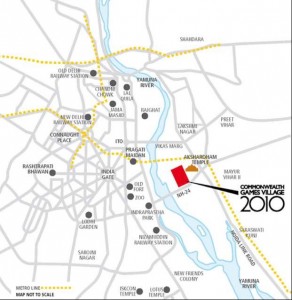TECHNICAL NEWS
Commonwealth games village, Delhi – Liquefaction study

Figure 1 Site Location
1 INTRODUCTION
Sanjay Gupta and Ravi Sundaram, Email: cengrs@gmail.com
Cengrs Geotechnica Pvt. Ltd., A-100, Sector 63, Noida-201309 (INDIA), www.cengrs.com
The Commonwealth Games -2010 were held in New Delhi, India in October 2010. The various sporting events were organized in different venues / stadiums all over the city. Sports persons from over 70 countries participated in the Games that lasted for over 10 days.
The event was inaugurated at the Jawaharlal Nehru Stadium by Prince Charles of Great Britain in the presence of the Indian President, Her Excellency Mrs. Pratibha Patil and Prime Minister, Dr. Manmohan Singh.
To accommodate over 8500 athletes and officials during the event, the Commonwealth Games-2010Village were constructed in the heart of Delhi (India) near I.P Estate and the Akshardham Temple on a 40-acre land. It is on the east bank of the River Yamuna. Fig. 1 presents the location of the village and Fig. 2 presents the Master Plan of the village complex.
Buildings Constructed
The structures constructed include a multi-storied housing complex with stilts, and upper floors ranging from 5 to 9 storeys in different towers. A total of 34 towers were constructed. A single basement is planned in the tower blocks, while the non-tower blocks are without basement. Badminton courts, a swimming pool, golf greens, promenade and food plaza, landscaped gardens, beautiful fountains, water bodies, etc. add to the elegance and charm of the area.
The site is fairly level with ground levels ranging from RL 201.9 m to RL 202.8 m. The average ground level is fixed as RL 202.5 m as per architectural plans.
2 GENERAL SITE CONDITIONS
Geological Setting
The project site is in East Delhi adjoining the Yamuna riverbed. The soils at the project site belong to the “Indo Gangetic Alluvium” and are river deposits of the Yamuna and its tributaries. The Pleistocene and Recent Deposits of the Indo-Gangetic Basin (Krishnan, 1986) are composed of gravels, sands, silts and clays. The newer alluvium, deposited in the areas close to the river, is locally called “Khadar” and consists primarily of fine sand, Yamuna Sand, that is often loose in condition to about 4-10 m below the ground surface.
Scope of Geotechnical Investigation
The scope of the geotechnical investigation included 14 boreholes to 30 m depth and 8 static cone penetrometer tests (SCPT). Also, 23 shear wave velocity tests were conducted using Spectral Analysis of Surface Waves (SASW) technique along six spreads across the site.
Download ISSMGE Bulletin – Volume 5 Issue 6 (pp. 45-52)
![]() PDF format
PDF format




































